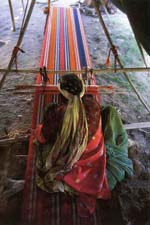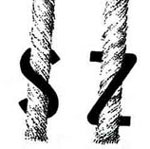ALL YOU WANT TO KNOW ABOUT GABBEH RUGS
GABBEH WEAVING TRIBES, TECHNIQUES,MATERIAL AND SIZE
Gabbeh Loom
Gabbehs are produced exclusively on
crude horizontal looms. Because of their material poverty and the arid lands
where the nomads migrate and live , the
materials for constructing a loom are those readily on hand . As the
consequence the bars on which the warps are stretched are invariably irregular
in from and size . as ease of transportation is important due to migration necessities
on nomads ,the loom only consist of warp bars , and a few crude wooden pegs to
anchor it down to the ground . It is the weighted with stones . Due to these
imperfections the rugs themselves could never be perfect. But each pieces turns
to be unique in its own way. Like all nomadic carpets.

Image1 -Qashqaie-Crude horizontal
loom
Gabbeh Size
Like all nomadic carpets, Gabbehs
are seldom particularly large. The typical length varies
Between 1.70 and 2.00 m (5-8 to
6-6 ). And the width between 0.9 and
1.3 m (3-00 to 4-4) Very rare
examples measuring some 2.60 by 1.50 m ( 8-6) by 5-0) do occur.
However the new modern age Gabbehs
which are woven by expert tribal weaver on special size loom set up for western market and exported by merchant in
trade to Europe and united state are larger in size ,in order to meet western worlds decorative needs .
These new typ are mostly palin
Gemetric field , and are different from our collection of gabbeh presented in
this web site .

Image 2 Two Qashqaie weaver on small loom
Gabbeh with Persian
and Turkish knots
Just as there are many Gabbeh
designs, there are also many technical peculiarities. There
is no typical structural
characteristic to identify a Gabbeh because all of the techniques used in the
production of other carpets are used here .
Both Turkish symmetrical and Persian asymmetrical
knots are used and can even be found together in the same rug. These structural
problems are probably the main reason why gabbehs have not been classified into
sub-tribal groups ( see Tanavoli Books
on Gabbeh ).

|
|
Wool Spinning in S and Z Shapes
|
|
Gabbeh Size
Like all nomadic carpets, Gabbehs are seldom particularly large. The typical length varies between 1.70 and 2.00 m (5'-8" to 6-6" ).
And the width between 0.9 and 1.3 m (3'-00" to 4-4") Very rare examples measuring some 2.60 by 1.50 m ( 8'-6") by 5'-0") do occur.
However the new modern age Gabbehs which are woven by expert tribal weaver on special size loom set up for western market and exported by merchant in trade to Europe and united state are larger in size ,in order to meet western world's decorative needs.
Thes enew typr are mostly palin Gemetric field , and are different from our collection of gabbeh presented in this web site .
Gabbeh with Persian and Turkish knots Just as there are many Gabbeh designs, there are also many technical peculiarities.
There is no typical structural characteristic to identify a Gabbeh because all of the techniques used in the production of other carpets are used here. Both Turkish symmetrical and Persian asymmetrical knots are used and can even be found together in the same rug. These structural problems are probably the main reason why gabbehs have not been classified into sub-tribal groups (see Tanavoli Books on Gabbeh ).
Gabbeh materials
As a genera1 rule Gabbeh s can be recognized by their long pile and loose knotting, but there are exceptions.There are a few very fine, thin, velvet-like Gabbehs with few wefts between the row knots.
In the average Gabbeh there are about five wefts between rowes but there could be as many as twelve and they may be of different materials such as fine to coarse wool, goat hair and cotton. They all can be found in one rug.
GABBEH WEAVING TRIBES OF FARSE
Qashqaie and Lori gabbehs
Most Gabbehs can be loosely attributed to the Qashqaie or Lori tribal groups . Normally they are differentiated from each other by the thickness of the warps. Lori's tend to use a thicker warp with thick wefts drawn tightly through them . Often after a row of knots , there is one goat hair weft then four or five woolen ones making up a quarter of an inch of flat weave which is covered by the lengthy pile.
The general looseness of the warps and wefts gives the Lori Gabbeh a soft and floppy feel .
Qashqaie Gabbeh Designs
Qashqaie Gabbehs strike one as being outstanding because of their more elaborate and complex designs, roses , Chosrou and Shirin ( figural ), Lion ( especially those in filled with numerous small motifs), ducks and trees of life .These pieces have a thick , dense pile.
The Lori pieces seem to be more openly worked , more unusual , less regular and less tidy. There are many more warps in a Qashqaie Gabbeh. They can be so densely packed that the individual warps are at an angle to each other and give the back of the carpet a ridged appearance.
The wefts tend to be red or brown in color, numerous but thin and loosely pulled through the warps which allowes them to be very tightly beaten down. This makes most Gabbeh very heavy and stiff, rather like a Heriz or a Bidjar carpet. It is only possible to roll this kind of Gabbeh.
Sub-tribes of Qahqaie in South - Western region of Farse
All Qahqaie sub- tribes in Farse region weave Gabbeh for their own nomadic life usage , however some sub-tribes are known for their expert rug weaving quality such as Kashquli tribes. which weave those beautiful Qashqaie rugs. Other Gabbeh weaving tribes that I have come in contact with are; Darreh Shuri, Ammaleh, Khamseh, Farsi Madan.
After researching a lot on Gabbeh weaving tribes in their summer and winter quarter ,one can differentiate the Gabbeh woven by these sub-tribes ,mostly from the various design type of Gabbeh .
Lion Gabbeh , Figural and Tree of Life is only woven by a few sub-tribes of Qashqaie in Shiraz , Farse Region.
|

